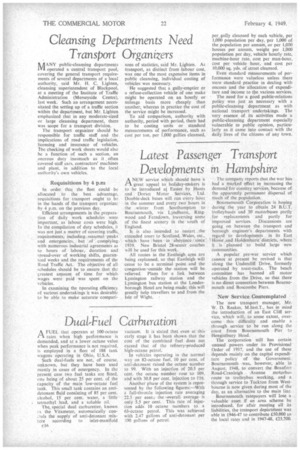Dual-Fuel Carburation
Page 22

If you've noticed an error in this article please click here to report it so we can fix it.
AFUEL that operates at 100-octane rates when high performance is demanded, and at a lower octane value when peak performance is not required, is employed in a fleet of 188 tank wagons operating in Ohio, U.S.A.
Such dual-fuels are not, of course. unknown, but they have been used mostly in cases of emergency. In the present case two fuel tanks are fitted, one being of about 25 per cent. of the capacity of the main low-octane fuel tank. This small tank contains an antidetonant fluid consisting of 85 per cent. alcohol, 15 per cent. water, a little tetraethyl lead, and a soluble oil.
The, special dual carburetter, known as the Vitameter, automatically con.7ols the supply of anti-detonant mixture according to inlet-manifold c16 vacuum. It is stated that even at this early stage it has been shown that the cost of the combined fuel does not exceed that of the refinery-produced high-octane petrol.
In vehicles operating in the normal way on 82-octane fuel, 10 per cent. of anti-detonant raised the octane number to 99. With an injection of 20.5 per cent. the octane number rose to 109, and with 30.8 per cent, injection to 116. Another phase of the system is represented by the following figures:--With a full-throttle injection rate averaging 22.5 per cent; the -overall average is only 5.5 per cent This rate of injection adds 10 octane numbers to a 63-octane petrol. This was achieved with 2.47 gallons of anti-detonant per 00 gallons of petrol


























